Figures & data
Figure 1. Exceptional characteristics of the genus Ulva, demonstrating the reasons for its increased attention in diverse industries. High morphological plasticity: (Blomster, Maggs, and Stanhope (Citation1999); Hayden et al. (Citation2003); Wichard et al. Citation2015; Steinhagen, Weinberger, and Karez (Citation2019); Steinhagen et al. (Citation2023); massive proliferation: (Charlier et al. (Citation2006); Charlier, Morand, and Finkl (Citation2008); Smetacek and Zingone (Citation2013); Gao et al. (Citation2010); Steinhagen Weinberger, and Karez (Citation2019)); high growth rates and ability to thrive at high stocking density: Mata, Schuenhoff, and Santos (Citation2010); Lawton et al. (Citation2013); Al-Hafedh, Alam, and Buschmann (Citation2014); Sebök, Herppich, and Hanelt (Citation2019); Stedt, Toth, et al. (Citation2022); rapid nutrient uptake potential: Gao et al. (Citation2013); Shahar et al. (Citation2020); rStedt et al. (Citation2022); wide environmental tolerance: Toth et al. (Citation2020); Kirst (Citation1990); Ghaderiardakani, Coates, and Wichard (Citation2017); Bao et al. (Citation2022); Thompson & Coates (Citation2017); Ghaderiardakani et al. (Citation2022); Steinhagen, Larsson, et al. (Citation2022); Simon, McHale, and Sulpice (Citation2022); Steinhagen, Enge et al. (Citation2021); Kraft, Kraft, and Waller (Citation2010).
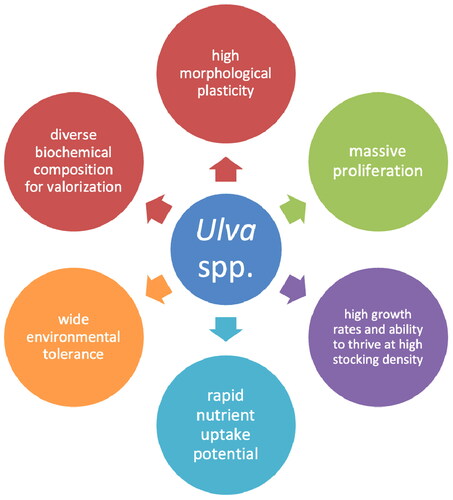
Figure 2. Global production of green seaweeds reported in the FAO database since the 1970s reported by country; grey, Ulva spp. in South Africa; green, Ulva spp. in Vietnam; blue, M. nitidum in South Korea; orange, U. prolifera in China; not visible due to insignificant amounts: Ulva spp. produced in Portugal and Spain.
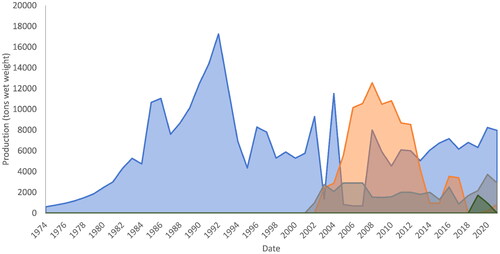
Table 1. Average and maximum global production of green seaweeds by country, 1950–2019 (Cai Citation2021; FAO Citation2022).
Table 2. Nutritional composition of different species of Ulva.
Table 3. Mineral composition of different species of Ulva.
Figure 3. A principal component analysis of the amino acid profiles (% of protein) of various Ulva spp. from different geographic regions and cultivation conditions. Data are taken from Supplementary Table 3 and analyzed using JMP® pro v. 17 (SAS Institute Inc., Cary, NC, USA). Prior to analysis, data underwent a log + 0.1 transformation. The “contrib scale” indicates the contributions (in percentage) of the variables to the principal axes. LSS: large scale system; MSS: medium scale system (Peña-Rodríguez et al. Citation2011). Arg: arginine; ala: alanine; asp: aspartic acid; cys: cysteine; gly: glycine; glu: glutamic acid; his: histidine; ile: isoleucine; leu: leucine; lys: lysine; met: methionine; phe: phenylalanine; pro: proline; thr: threonine; tyr: tyrosine; ser: serine; val: valine.
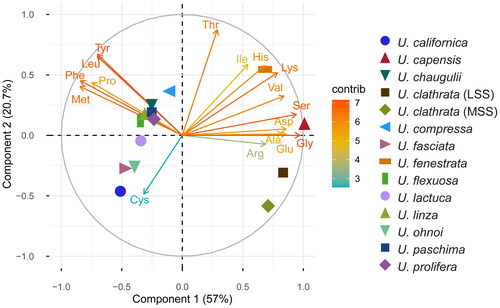
Figure 4. Principle component analysis (Martin and Maes Citation1979; Becker and Venkataraman Citation1984; Venables Citation1997) of the nutritional content (ash, protein, lipids, carbohydrates) of different Ulva spp. and soy, corn, rice and wheat. Data for Ulva were taken from as percentages. When single values were missing, mean values were used. Data for soy, corn, rice and wheat were taken from the United States department of agriculture food data Central website (https://fdc.nal.usda.gov/index.html.) as percentages. The analysis was performed using the environment of R (version 4.02.), RStudio (version 2022.02.3). Data were not transformed prior to analysis. Percentages were transformed by arcsine-square-root transformation to correct for deficiencies of the proportions in normal distribution.
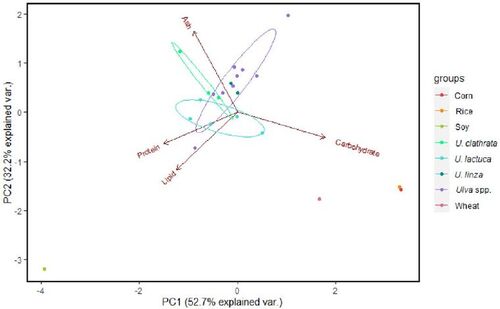
Figure 5. Principal component analysis (PCA) of the fatty acid profiles (left panel) of various Ulva spp. grouped by morphology (tubular or foliose/blade, right panel). Two species known to exhibit both morphologies were labeled as “both.” data were sourced from Supplementary Table 2 and analyzed using JMP® pro v. 17 (SAS Institute Inc., Cary, NC, USA). Prior to analysis, data underwent a log + 0.1 transformation. Trace values (less than 0.1%) were substituted with 0.001%.
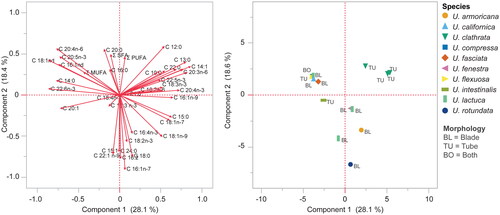
Table 4. Summary of the effect of Ulva-supplemented aquafeed on different cultivated seafood.
Table 5. Ulva biorefinery. Co-production of various ingredients from Ulva and their transformation to additional products.
